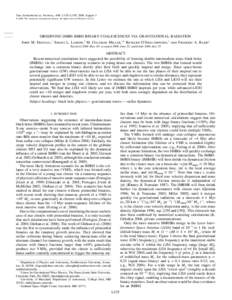 Date: 2014-01-14 01:28:45Black holes Star clusters Gravitational-wave astronomy Binary stars LIGO Gravitational wave Globular cluster Cosmic distance ladder Cluster chemistry | |  The Astrophysical Journal, 646: L135–L138, 2006 August 1 䉷 2006. The American Astronomical Society. All rights reserved. Printed in U.S.A. OBSERVING IMBH-IMBH BINARY COALESCENCES VIA GRAVITATIONAL RADIATION John M. F The Astrophysical Journal, 646: L135–L138, 2006 August 1 䉷 2006. The American Astronomical Society. All rights reserved. Printed in U.S.A. OBSERVING IMBH-IMBH BINARY COALESCENCES VIA GRAVITATIONAL RADIATION John M. F
Add to Reading ListSource URL: sciencejedi.comDownload Document from Source Website File Size: 78,23 KBShare Document on Facebook
|

